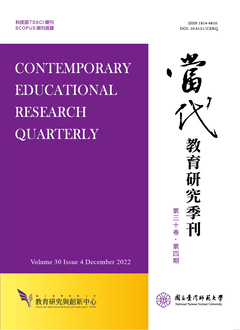

本研究旨在以學習策略觀點建構科學教育網站評鑑指標。先從文獻分析提出指標雛形架構。再以專家問卷與模糊德懷術問卷,確定指標層級架構與內涵。最後由模糊層級分析法驗證層級結構性並賦予各指標相對權重值。研究發現:一、科學教育網站評鑑指標權重體系具整體一致性、適切可行,包含3 項第一級指標、11 個第二級指標與37 項第三級指標;二、第一級指標有認知策略、後設認知策略、資源管理策略,其中認知策略的權重值最高;三、第二級指標有複誦與選擇策略、精緻化策略、組織策略、演練策略、計畫策略、監控策略、調整策略、時間管理、努力管理、環境管理、回饋支持指標等,其中回饋支持、演練策略、複誦與選擇策略三項的權重值較高。
This study aimed to construct the Science Education Website EvaluationIndicators (SEWEI) from the perspective of learning strategy. The study appliedthe expert questionnaire, fuzzy Delphi method, and fuzzy analytic hierarchyprocess as the main methods. After systematic literature reviews with regardto learning strategy and website evaluation, the first frame of indicators wasestablished. The expert questionnaire was to modify the first frame of indicatorsand form the fuzzy Delphi questionnaire; the fuzzy Delphi method was to assessthe quality and the suitable degree of the indicators; the fuzzy analytic hierarchyprocess was to estimate the indicators weight. The major conclusions of thisstudy were listed as below: (1) There were 3 first-level indicators, 11 secondlevelindicators and 37 third-level indicators of the SEWEI, which contained anoverall consistency and measurable value. (2) The first-level indicators includedcognitive strategy, metacognition strategy and resource management strategy. Theweight of cognitive strategy was the highest among all first-level indicators. (3)The second-level indicators included rehearsal & selection strategy, elaborationstrategy, organizational strategy, practice strategy, planning strategy, monitoringstrategy, regulating strategy, time management, effort management, environmentalmanagement and feedback & support. The weights of feedback & support, practicestrategy, and rehearsal & selection strategy were the highest among those secondlevelindicators.

本著作係採用創用 CC 姓名標示-非商業性 3.0 台灣 授權條款授權.
本刊國立台灣師範大學教育研究與創新中心
106台北市和平東路一段162號 | 電話: 02-7749-3670 | E-mail: cerecerq@gmail.com
教創中心 | 師大 | 電子報 | 線上投審系統
本刊由國家科學及技術委員會人文社會科學研究中心補助經費
© 2014 CERI-NTNU
